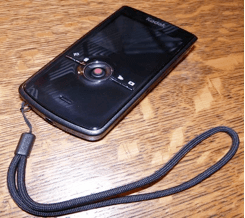In a previous blog post, I mentioned I had a Kodak Zi8 video camera. This past weekend, I decided I wanted to try Windows Movie Maker (WMM) to edit videos produced with it, instead of the built-in Arcsoft MediaImpression software that the camera installs on the PC it is connected to.

(Although I haven’t tested it, the procedure described below probably also works well with the newer Kodak cameras such as the PlaySport and PlayTouch that also use an Ambarella encoder.)
The first issue I ran into was that WMM would not import the .MOV files the camera produces. Apparently if you use Windows 7, Windows Live Movie Maker may be able to import these files directly — I found conflicting reports on the web. But I have Windows XP, so I needed to find a way to use the older WMM.
I experimented with converting the output of the camera to several formats and found the format that worked best was AVI format files. I also tried WMV and MPEG-2 formats, but had issues with video artifacts in the editor.
First, you will need to install an appropriate set of codecs for your PC. To do this, I installed the ffdshow-tryouts package on my PC.
Then, I used ffmpeg to convert the h.264/MOV format file the camera produces to MPEG-4/AVI format:
ffmpeg –i input.MOV –sameq output.AVI
In the line above, I’m transcoding the video from h.264 to MPEG-4 part 2 at the same time I am converting the container format from MOV to AVI. This seems to be the combination that WMM is happiest with, in terms of preview working well and so forth. My version of WMM seems to want an AVI container — although it supports some others but not as well. Then the question becomes what codec to use inside it, and h.264 doesn’t seem to work on XP or Vista. So the combination of MPEG-4 part 2 / AVI seems to be the answer that works well on all three platforms (XP, Vista, and Windows 7).
I was able to import the resulting video into WMM and edit it. I did find that WMM had two peculiarities. The first is that it does not store the aspect ratio of the video in the project. For video from the Zi8, you will want to choose a 16:9 aspect ratio. The default is 4:3. To change this, in WMM, click “Tools” on the Movie Maker menu, and then choose “Options.” In the resulting dialog, click on the “Advanced” tab and choose the 16:9 widescreen aspect ratio.
The other limitation is somewhat disappointing: WMM will only output standard definition video (480p). I shot the original footage in 1080p, but there was no way to preserve this through the editing process. While the Arcsoft video editor that comes with the camera offers fewer creation options, it does handle HD video throughout the workflow, and the final video has fewer artifacts and is of higher quality.